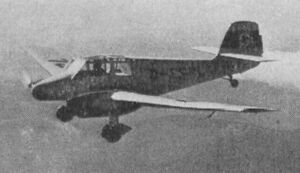Engineering:Gotha Go 150
| Gotha Go 150 | |
|---|---|

| |
| Role | Light aircraft |
| National origin | Germany |
| Manufacturer | Gothaer Waggonfabrik |
| Number built | 12 |
The Gotha Go 150 was a light aircraft designed at the German company Gothaer Waggonfabrik in the late 1930s. It was intended for civilian use, but ended up being used as a military trainer.
Development
In January 1937 Major Werner Junck, chief of the LC II, the technical wing of the Reichsluftfahrtministerium responsible for the development of new aircraft, informed various minor aircraft manufacturers such as Gothaer Waggonfabrik, Bücker, Fieseler, Flugzeugwerke Halle and Klemm that they would not get any contracts for the development of military aircraft. He therefore advised them to concentrate in the development of a Volksflugzeug or a small twin-engined plane. As a result, Gothaer Waggonfabrik developed the Go 150, while the other companies produced the Kl 105, the Si 202, the Bü 180 and the Fi 253.
The aircraft was a twin-engined monoplane with an enclosed cockpit. It was designed by Albert Kalkert, and first flew in 1937. The results of this flight were good, and production began. The aircraft was used to train both civilian and Luftwaffe pilots. The Go 150 was later also used in tests, where it was towed by a Heinkel He 46.[1]
Specifications
Data from Flugzeug-Typenbuch : Handbuch der Deutschen Luftfahrt- und Zubehör-Industrie 1939/40[2]
General characteristics
- Crew: 1
- Capacity: 1 pax
- Length: 7.15 m (23 ft 5 in)
- Wingspan: 11.8 m (38 ft 9 in)
- Height: 2.03 m (6 ft 8 in)
- Wing area: 17.5 m2 (188 sq ft)
- Aspect ratio: 7.88
- Width folded: 3.85 m (13 ft)
- Empty weight: 512 kg (1,129 lb)
- Gross weight: 850 kg (1,874 lb)
- Max takeoff weight: 1,036 kg (2,284 lb) [citation needed]
- Fuel capacity: 150 L (40 US gal; 33 imp gal) fuel ; 7 L (1.8 US gal; 1.5 imp gal) oil
- Powerplant: 2 × Zündapp Z 9-092 4-cylinder inverted air-cooled in-line piston engine 50 / 55 PS (49 / 54 hp; 37 / 40 kW) take-off/max continuous
- Propellers: 2-bladed fixed-pitch wooden propellers, 1.55 m (5 ft 1 in) diameter
- Propeller disc area: 3.76 m2 (40.47 sq ft)
- Propeller loading: 26.6 PS/m2 (2.44 hp/sq ft; 19.6 kW/m2)
Performance
- Maximum speed: 200 km/h (120 mph, 110 kn)
- Cruise speed: 185 km/h (115 mph, 100 kn)
- Landing speed: 70 km/h (43 mph; 38 kn)
- Range: 750 km (470 mi, 400 nmi)
- Endurance: 4 hours 5 minutes
- Service ceiling: 4,500 m (14,800 ft)
- g limits: +6.03 (ultimate)
- Time to altitude: 1,000 m (3,300 ft) in 5 minutes 30 seconds
- Wing loading: 48.5 kg/m2 (9.9 lb/sq ft)
- Power/mass: 0.118 PS/kg (0.053 hp/lb; 0.087 kW/kg)
- Fuel consumption: 8.13 km/L (19.1 mpg‑US; 23.0 mpg‑imp)
- Take-off run: 400 m (1,300 ft)
- Landing run: 350 m (1,150 ft)
References
- ↑ Kay. Antony L.; John Richard Smith; Eddie J. Creek (2002). German aircraft of the Second World War: including helicopters and missiles. Naval Institute Press. p. 276. ISBN 978-1-55750-010-6.
- ↑ Schneider, Helmut (Dipl.Ing.) (1939). Flugzeug-Typenbuch : Handbuch der Deutschen Luftfahrt- und Zubehör-Industrie 1939/40 (Facsimile reprint 1988 ed.). leipzig: Gondrom. ISBN 3811206273.
Bibliography
- Metzmacher, Andreas (2021). Gotha Aircraft 1913-1954: From the London Bomber to the Flying Wing Jet Fighter. Brimscombe, Stroud: Fonthill. ISBN 978-1-78155-706-8.
External links
 |

